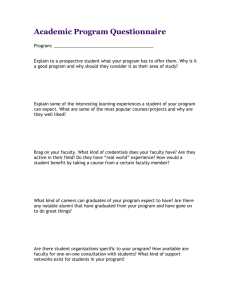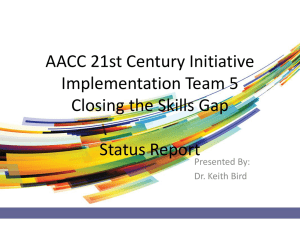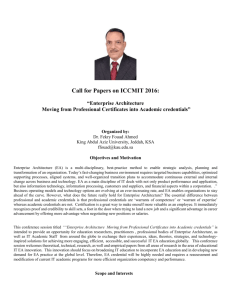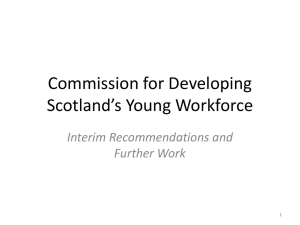Landscape Review of Innovations
advertisement
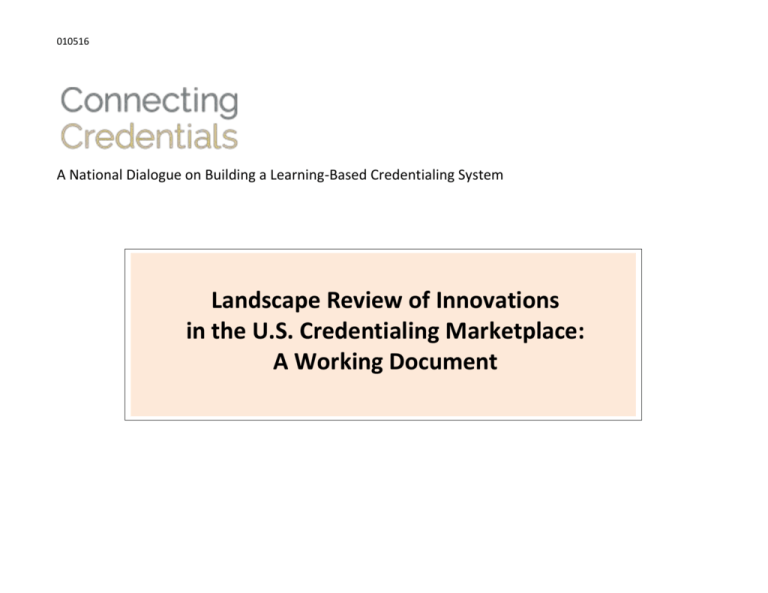
010516 A National Dialogue on Building a Learning-Based Credentialing System Landscape Review of Innovations in the U.S. Credentialing Marketplace: A Working Document CONTENTS Common language Nimble end-to-end quality assurance processes Scalable employer engagement approaches Flexible Pathways Data and Technology 3 5 5 9 13 2 Initial List of Innovations Related to Scope of Work Group Action Type of innovation # Brief Description Organization(s) and Funding source(s) Develop common language to serve as the basis for a connected credentialing system -Develop competency-based communications vehicles that increase transparency among credential issuers, holders, and employers -Improve the interface of credentials across sectors (military/civilian, industry/academic, etc.) -Develop digital badges to communicate clearly about skills Competency as the common language 1 Connecting Credentials: Beta Credentials Framework uses competencies as common reference points to help users understand and compare the levels of knowledge and skills that underlie all credentials – including degrees, certificates, industry certifications, licenses, apprenticeships and badges. http://connectingcredentials.org 2 Clarifying Competency Based Education Terms: A Lexicon addresses and defines terms often used in the world of CBE -not all of which are commonly understood to have an accepted definition. http://bbbb.blackboard.com/Competencybased-education-definitions, The Readiness Project uses accessible and actionable research and communications to suggest common language for the dynamic abilities people use every day; the high frequency skills, habits and attitudes (competencies) that make-up those abilities; the practices that support the development of those skillsets and mindsets and, the gaps and traps that stand in the way of putting those abilities and practices into effect. Interactive Employability Skills Framework website is central clearinghouse of resources for policymakers, practitioners in education and workforce training, and others where they can identify employability skills and compare the skills identified by various instructional standards and assessments; understand key considerations for selecting an employability skills assessment; create a customized assessment comparison worksheet; and view practical examples of employability skills instruction and assessment. http://cte.ed.gov/employabilityskills/app/webroot/files/Employability_Skills_Framework.pdf Ongoing stream of work that ties degrees, certificates, industry-based certifications, non-credit education, and licenses to labor market value. The work also drills down below the level of degree attainment and/or program to core competencies required for success along education and career pathways. Core occupational competencies include occupational knowledge, skills, abilities, work values, work interests, and personality traits. See following reports: Recovery 2020, College Payoff, Certificates Degree Qualifications Profile (DQP) is a learning-centered framework outlining what college students should know and be able to do upon completion of associate, bachelors and master’s degrees – in any field of study. Paired with the complementary, discipline-specific process of Tuning, the DQP engages faculty in the work of improving courses and programs of study: http://degreeprofile.org/ Liberal Education and America’s Promise (LEAP) is a national advocacy, campus action, and research initiative that champions the importance of a 21st century liberal education for individuals and a nation dependent on economic creativity and democratic vitality: https://www.aacu.org/leap. Its efficacy and scalability are being tested in the MultiState Collaborative to Advance Learning Outcomes Assessment led by SHEEO involving about 100 colleges/universities in 12 states. https://www/sheeo.org/projects/msc-multi-state-collaborative-learning-outcomes-assessment. General Education Maps and Markers (GEMs) shows educators how to apply the proficiencies and competencies articulated in the 3 4 5 6 Competencybased standards in education 7 Corporation for a Skilled Workforce, Center for Law and Social Policy, Lumina Foundation ACE-Blackboard Ford Foundation Office of Career, Technical & Adult Education, U.S. Department of Education Georgetown University Center on Education & the Workforce -- Gates, Lumina & Joyce Foundations National Institute of Learning Outcomes Assessment, Lumina Foundation AAC&U member contributions -- Gates & Lumina Foundations 3 8 Institutionalizing credentialing in the military 9 10 Competencybased transcript to increase transparency for employers 11 12 Digital badges (digital passports) to communicate clearly about skills 13 14 15 16 Degree Qualifications Profile (DQP) to the design of integrative and equity-minded general education programs, from first to final year. Guides from this project are available at www.aacu.org/GEMs . Several dozen colleges, universities and community colleges are applying GEMs guidelines through AAC&U grant funded LEAP initiatives. A GEMs report on digital strategies for achieving key learning outcomes will be released in 2016. Supports states’ efforts to ensure all students graduate from high school ready for college and careers and is in the early stages of work to understand and make recommendations about the role of k-12 in addressing the “skills gap.” Achieve provides targeted policy and implementation support to a group of states committed to advancing K-12 competency-based pathways (CBP) to college and career readiness for all students. CBP State Partnership: Support to States in Advancing Competency-Based Pathways. Military Credentialing and Licensing Task Force oversees and coordinates DOD and Service level initiatives related to credentialing and licensing. http://blog.dol.gov/tag/defense-department-military-credentialing-and-licensing-taskforce/http://www.nga.org/files/live/sites/NGA/files/pdf/2014/1410VeteransLicensingDoDCredentialing_Cain.pdf NGA conducted a Veterans’ Licensing and Certification Policy Academy for states to support this effort. Postsecondary Electronic Standards Council’s Task Force on Academic Credit and Experiential Learning is developing postsecondary electronic standards. CBE and eT (extended transcript) initiative to create and test a conceptual framework and series of prototypes developed in conjunction with IMS members, AACRAO, C-BEN (Competency Based Education Network): http://www.imsglobal.org/cbe/index.html Open badges is a technology standard initially developed and incubated at Mozilla, funded by MacArthur Foundation. The work continues under Badge Alliance which is promoting a network of organizations to come together to lay the foundation for interoperable digital credentials based on an open technical standard: http://openbadgespec.org/ Building an ecosystem of micro-credentials for professional educators through which they can receive formal recognition for skills and competencies they develop throughout their careers. Micro-credentials are awarded based on artifacts and evidence of granular competencies that are assessed by experts and/or peers. Digital Credentialing Currency Framework Initiative: By collectively investigating and pursuing a framework for developing social, academic, and professional currency for digital credentials, IMS seeks to ensure that credentials are developed, used, and valued in consequential ways. The framework aims to help organizations, institutions, and individuals develop, issue, earn, and share digital credentials in ways that are readily understandable, easy to reproduce, and that carry value for all stakeholders in a variety of environments, including academia and industry. The Get Skills to Work initiative matches military veterans with jobs in advanced manufacturing through a virtual Military Manufacturing Badge, which pulls up the veteran’s Military Occupational Specialty code (MOS) and information on civilian manufacturing skills the veteran demonstrated in the military; and accelerated training customized to manufacturing careers. www.getskillstowork.org 21st Century Skills Badging Challenge is using design thinking methodologies to lead individual universities through multiphase learning process that will conclude with prototypes of scalable, replicable and transparent methods to create rigorous, competency-based badges that demonstrate students’ 21st century skills. During the 2015-16 academic year “inmarket” tests of a suite of badges will be conducted with students and employers and ways to scale beyond the current pilot universities will be determined. Achieve U.S. Department of Defense, National Governors Association Center for Best Practices American Association of Collegiate Registrars & Admissions Officers, PESC IMS Badge Alliance, MacArthur Foundation Digital Promise IMS Global Members Manufacturing Institute, GE, Boeing, Lockheed Martin, Alcoa, other partners Education Design Lab 4 Create nimble end-to-end quality assurance processes to support portability and trust of credentials Ensure valid assessment of authentic learning and competencies Adapt quality assurance mechanisms for competency-based education Promote innovation in assessment and accreditation Promote licensing reforms to increase mobility/portability 17 Adapt quality assurance in education to accommodate competencybased education 18 19 20 21 22 Licensing reforms 23 24 25 Accreditation innovation 26 ACE is engaging employer voice in defining a national quality framework for competency-based education for signaling competencies gained through competency-based education. From this process ACE will develop a contextual framework for how academia can relay competency attainment to employers and what is needed in the assessment of competencies for employers to consider the evaluation of competencies credible. Convened a national group to develop a quality framework for stackable credentials which defines key dimensions of quality from four key stakeholder perspectives --consumers, earners, endorsers, issuers. A White Paper based on this work will be issued in late 2015. Under Federal HEA Title IV experimental sites authority, conducting experiments on how to accommodate Prior Learning Assessment, Competency-Based Education and Limited Direct Assessment under federal student financial aid programs: https://experimentalsites.ed.gov/exp/approved.html CBE Landscape Project designed 10 Shared Design Elements and Emerging Practices of Competency-Based Education. These design elements are associated with healthy and robust CBE programs in higher education. This project also included a survey of approximately 500 institutions developing or delivering CBE programs, which produced useful information for establishing quality assurances for CBE programs Common Framework for Defining and Approving Competency-Based Education Programs: http://www.wascsenior.org/node/1282 With leadership from the First Lady and Dr. Biden, 23 states passed pro-military spouse licensing portability measures. https://www.whitehouse.gov/blog/2012/06/26/23-states-have-now-passed-pro-military-spouse-license-portabilitymeasures Veterans Licensing and Certification Demonstration Project involves 6 states who are developing and implementing accelerated pathways to civilian licensure in high-demand occupations for transitioning service members. The project supports cross-sector state teams to work with state licensing boards and community colleges to create pathways that avoid or reduce duplicative training for service members with relevant military training and experience. Description/interim findings for project found here. GU CEW is conducting a 50 state review of the connection between occupational licensing and programs of study. In collaboration with (EDEPS) the Economic Development and Employer Planning System database. Accredits clean energy training providers and certifies instructors and master trainers nationally. IREC is currently piloting two new stackable micro-credentials that would be renewed and upgraded over time using a streamlined validation process to lower costs, and provide value in the marketplace. www.irecusa.org The first exclusively online university to receive accreditation for its competency-based degree programs that lead to teacher licensure from the National Council for the Accreditation of Teacher Education (NCATE). http://www.wgu.edu/about_WGU/accreditation American Council on Education, Gates Foundation ACE, Gates U.S. Department of Education Public Agenda, Forum for Youth Investment – Gates & Lumina Foundations Council of Regional Accrediting Commissions Federal National Governors Association, US Department of Labor Georgetown University Center on Education and the Workforc, Gates, Lumina & Joyce Foundations Interstate Renewable Energy Council Western Governors University’s Teachers College 5 Create scalable employer engagement approaches to improve demand signals and increase relevancy and currency of credentials • Improve demand signals to increase the relevance of credentials in a rapidly changing marketplace • Support collaboratives that are by business, for business and that manage the talent pipeline as a shared activity across employers • Enhance employer talent acquisition and advancement by improving how they communicate their skill needs and requirements • Promote accelerated work-based education and training by strengthening performance-driven partnerships Common Employability Skills is a core set of fundamental skills that potential employees need in the workplace—and a common vocabulary to explain them. http://businessroundtable.org/sites/default/files/Common%20Employability_asingle_fm.pdf To help workers, students and employers identify and utilize the credentials that really matter, the NNBIA has developed a list of quality attributes as well as a guide to help organizations design and develop new industry-recognized credentials that meet these quality attributes. Multiple efforts on the ground (e.g., City of Albuquerque, Governor’s Office of Economic Development, Turning Point WIB, Utah) to piloti demand- driven validation of core competencies, with focus on employer hiring based on continually updated and validated skills/competencies. National Network of Business and Industry Associations --Lumina, Joyce, ACT & Walmart Foundations 29 Provides most widely utilized projections of employer demand for educational degrees and certificates, nationwide and for individual states. The Center’s projections are used by employer associations to gauge hiring demand and used by state postsecondary systems to create credentialing goals. Georgetown University Center on Education & the Workforce -- Gates, Lumina & Joyce Foundations 30 Works with more than a dozen states to develop tools that use State Longitudinal Data Systems (SLDS) data to: (1) Balance enrollments relative to labor market demand. (2) Align curriculum with workforce requirements. (3) Connect counseling to career pathways. (4) Assist in job placement and skill gap analysis. (5) Assist in workforce planning for business expansion and economic development. See report: Recovery 2020 Georgetown University Center on Education & the Workforce -- Gates, Lumina & Joyce Foundations 31 National Governor Association Center for Best Practices 32 Fourteen states are participating in the Aligning the Education and Training Pipeline to the Needs of the Economy Policy academy and as part of that academy, NGA is developing a State Policy Guide on Identifying Credentials of Value. http://www.nga.org/cms/home/nga-center-for-best-practices/meeting--webcast-materials/page-edu-meetingswebcasts/col2-content/main-content-list/nga-talent-pipeline-policy-acade.html Conducting employer survey on challenges and impediments they face 33 Focuses on developing pathways to achieve high skill workforce outcomes in high demand and emerging fields 34 Trade Adjustment Assistance Community College and Career Training (TAACCCT) grants are supporting capacity-building to spur innovation and development of model training programs at community colleges and universities, including fully engaging employers and industry organizations in curriculum development; career pathway development; and defining 27 Better demand signals to increase relevance of credentials to changing labor market 28 Innovate+Educate – Joyce and Walmart Foundations Committee on Economic Development Business Higher Education Forum U.S. Department of Labor 6 Industryeducation partnerships to promote relevance and currency of educational programs and work-based learning 35 36 37 38 39 and mapping competencies, credentials and work-based training and hiring. http://www.doleta.gov/taaccct/applicantinfo.cfm Talent Management Pipeline initiative seeks to partner with colleges and employers to create a talent pipeline that enables students to efficiently acquire in-demand skills. http://www.uschamberfoundation.org/talent-pipelinemanagement AT&T/Udacity Nanodegree program is a Massive Open Online Course (MOOC). Nanodegree credentials will be awarded for mastery of entry-level software skills needed for high-demand jobs in the tech industry and fully recognized for entrylevel software jobs at AT&T. AT&T and Udacity are offering 1200 scholarships that will be distributed by local and national non-profit organizations in order to further ensure traditionally underserved students have access to these credentials. Other leading tech companies, such as Google, are also creating Nanodegree programs with Udacity. https://www.udacity.com/nanodegree Industry-education partnership that supports professional development and curriculum development in community colleges and high schools leading to industry certification in the aviation, transportation, manufacturing and energy sectors. To date, over 4000 industry certifications have been issued by 375 educational institutions. http://www.nc3.net/ Skills for America’s Future promotes partnerships between employers and community colleges College Employer Collaborative between community colleges and leading employers enables students to learn in-demand skills through an innovative online curriculum developed by employers and postsecondary education. 40 Hosts national industry roundtables to learn about skill and credential needs of specific sectors and then forms affinity groups with Goodwill members to promote well-informed sector initiatives in local areas. 41 Scale High-Quality Work-based Learning is a 2-year project launching this fall that will support 6 states to: elevate the role of work-based learning in connecting students and young adults to middle skills STEM jobs; identify the components of high-quality work-based learning and exemplar programs; and leverage state education and workforce systems to scale participation in those high-quality programs statewide. Promotes partnerships, emphasizing STEM in career readiness for future jobs. Partners with employers nationwide to offer fully accredited associate’s and bachelor’s degree programs to their frontline employees for $2,500 a year, usually paid in full or part by employer’s tuition assistance plan. Students are awarded a degree and diploma from Southern New Hampshire University based on demonstrated mastery of competencies through project-based learning. Working to implement the recommendations of its Task Force on Improving Career Readiness, which includes the recommendation that state education leaders “enlist the employer community as a lead partner in defining the pathways and skills most essential in today’s economy.” CCSSO is supporting a network of states as they develop cross-sectoral partnerships and establish these pathways. Northeast Resiliency Consortium provides competency based training and new coursework in resiliency leading to credentials needed for occupations that build stronger, safer, and more prosperous communities while mitigating the short and long term effects of recent disasters and future threats. 42 43 44 45 U.S. Chamber of Commerce Foundation AT&T/ Udacity National Coalition of Certification Centers Aspen Institute Jobs for the Future, CorpU Goodwill Industries International and Goodwill agencies Siemens Foundation, National Governors Association Center for Best Practices Skills USA College for America Council of Chief State School Officers Achieving the Dream, Carnegie Foundation for the Advancement of Teaching, TAACCCT grant, Passaic, Atlantic Cape, LaGuardia, Kingsborough, Housatonic, Capital & 7 46 47 Partners with secondary schools to implement career-focused STEM education programs. 48 The goals of the $100 million American Apprenticeship Grant program include creating career pathways that encompass American Apprenticeship in high growth industries and align with other post-secondary educational offerings. Technical assistance academy for recipients of the US Department of Labor’s American Apprenticeship grant program. 49 Apprenticeshipspecific initiatives 50 51 Competencybased hiring In 2014, T.E.A.C.H. Early Childhood® (T.E.A.C.H.) raised $400 million public and private dollars to provide scholarships and other supports for professional development of early childhood teachers in 23 states and DC, supporting over 16,000 employees working with 8,110 different employers. Those working on two or four year degrees who completed 14 credit hours while working full time, saw an 8% wage gain and had turnover rates of 4-6 percent, which are low for the industry.. http://teachecnationalcenter.org/ The Registered Apprenticeship College Consortium (RACC) is a national network of postsecondary institutions, employers, unions and associations working to provide accelerated pathways to earn an associate’s or bachelor’s degree by giving college credit for apprenticeship program participation: http://doleta.gov/oa/racc.cfm Economist-led case study of return on investment of registered apprenticeship for U.S. employers will analyze the training investments of diverse firms to uncover how employers committed to registered apprenticeship account for costs and benefits of the training model. 52 Issued 5 case studies on Innovations in Apprenticeship: https://cdn.americanprogress.org/wp-content/uploads/2014/09/ApprenticeshipInnov-report1.pdf 53 Issued Employer Apprenticeship handbook http://www.themanufacturinginstitute.org/~/media/14B36E1969704C3BADF11A1BE0F21B3D.ashx Developing guide to help organizations design new industry-recognized credentials and conducting research to determine the extent to which employers are hiring for competencies. 54 Bunker Hill community colleges, employers College Board 55 Several of America’s top companies have committed to NAFTrack Certified Hiring, a promise to give special consideration to college students and eventual job applicants who as high school students earned NAFTrack Certification which is based on a rigorous and comprehensive assessment of students’ academic proficiency, project execution and internship performance. http://quality.naf.org/naftrack-certified-hiring 56 TechHire is national initiative (as of August 2015 of 31 regional labor markets and 400+ employers) to better connect employers across multiple industries that need to hire and fill jobs in IT occupations to individuals who possess the skills and the motivation to be successful hires, but whose non-traditional pathways to acquiring those skills render them “invisible” to traditional recruiting processes in the IT field. Employers agree to hire (or offer paid apprenticeships with the intention to hire) on the basis of a range of demonstrations of competence or readiness – whether by alternative credentials or by assessments and/or capstone projects that can serve as “proxy credentials” with market value U.S. Department of Labor National Governors Association Center for Best Practices U.S. Department of Education and Labor US Department of Commerce; Joyce, JPMorgan Chase & Annie E. Casey Foundations; Case Western Reserve University Center for American Progress Siemens, DOW Chemical Company, Alcoa National Network of Business & Industry Network, ACT Foundation, Business Roundtable, Lumina Foundation National Academy Foundation Opportunity @ Work 8 57 58 Collaborates with designers, online talent platforms, employers, and educational institutions to build online platform to aggregate tools employers require to hire successfully based on demonstrations of competencies and on the “nontraditional” credentials that align to those competencies. Such tools include the Inclusive Hiring Playbook for IT Jobs, created in partnership with Corporate Executive Board (CEB), and an engine of employer feedback (quantitative and qualitative) on success of candidates sourced through TechHire’s “non-traditional” channels and hired based on competencies and alternative credentials, building national database with comparative employer feedback across hiring sources. Developing demand-driven, competency-based and research-backed training and hiring model across regions and states that pilots cognitive ability (learn how to learn) as core foundational skills for jobs across multiple sectors. Opportunity @ Work Innovate + Educate . Create flexible credentialing pathways leading to family-sustaining jobs to increase equity Advance system alignment of career pathways initiatives and stackable credentials connecting adult education, developmental education, youth, employers, and community based organizations. Pathways initiatives and stackable credentials include: high school to college, adult education to college, college to career, career to credential. Scale stackable credentials promoting articulation and transfer. Strengthen academic and career guidance and navigation supports, including efforts to reduce stigma about education, pathways, and training. Incorporate Credit for Prior Learning (CPL) into career pathways and stackable credentials. Promote research and study of stackable credential completers to understand impact and drive continuous improvement. 59 Clear pathways from high school to college to career 60 61 62 63 The Alliance for Quality Career Pathways is a partner-driven, CLASP-led initiative that developed a consensus framework to establish a common understanding of quality career pathways and systems, including stackable credentials, to help state and local/regional partnerships strengthen their career pathway systems. http://www.clasp.org/resources-andpublications/files/aqcp-framework-version-1-0/AQCP-Framework.pdf Supports the development of career pathways and stackable credentials. http://www.workforceinfodb.org/PDF/CareerPathwaysToolkit2011.pdf http://2rs11m47n9nefk1rmiofa51a.wpengine.netdna-cdn.com/wp-content/uploads/2015/05/The-Evolution-andPotential-of-Career-Pathways.pdf Linked Learning pathways integrate rigorous academics with career-based learning, real-world workplace experiences and comprehensive support services to prepare students to take credit-bearing college-level courses and be university admissible upon graduation from high school, maximize articulation between high school and postsecondary programs of study, and facilitate and accelerate completion of stackable postsecondary credentials, certificates, and degrees. Pathways to Prosperity program works with 12 states in promoting statewide systems of career pathways for grades 9-14 linking high school, work and community college. In addition, the Policy Leadership Trust for Student Success has a Task Force on Credit Transfer and one on 'Building Pathways to Credentials which works with community college presidents and state leaders to inform and influence the policy conditions and state infrastructure that support community college efforts to build clear pathways to credentials. Bridge the Divide program facilitates course content alignment from high school to community college to career. This fast track process results in the clear articulation of knowledge and skill accumulation and learning outcomes across courses Joyce & James Irvine Foundations, Greater Twin Cities United Way U.S. Departments of Education and Labor James Irvine Foundation, California Department of Education, California Community Colleges Jobs for the Future Educational Policy Improvement Center 9 64 65 Academic and career guidance and navigation supports 66 67 68 U.S. Department of Labor South Carolina Commission on Higher Education, AcademyOne Florida, AcademyOne JFF, YouthBuild Complete College America, USA Funds (for Purpose First), multiple sources (for GPS) 69 Siemens Technical Scholars program highlights, profiles, and markets successful millennials in STEM programs at top performing community and technical colleges with the goal of promoting awareness and a positive perception of the middle-skill jobs available with such credentials to millennials. Siemens Foundation, Aspen Institute 70 Multi-State Collaborative on Military Credit (MCMC), a 13-state initiative to identify policies and practices to help military service members, veterans, and their families to overcome barriers to access, participation, and completion of a postsecondary credential and entrance into the workforce. Global Learning Qualifications Framework -- assists students to document their verifiable college/university-level learning for academic credit and to provide an academic framework to evaluate student learning. http://www.esc.edu/sunyreal/global-learning-qualifications-framework/ Offers on-line credential service for prior learning assessment (PLA), advising services and promotes competency-based college and local programs. Midwestern Higher Education Compact– Lumina Foundation SUNY Empire State College – Lumina Foundation Council for Adult and Experiential Learning Learning Counts is a comprehensive one stop prior learning assessment (PLA) resource for adult learners, offering PLA guidance, prior learning portfolio development courses, and portfolio assessment services. It focuses on translating the experience and knowledge adult learners acquire outside the classroom into college credit. http://www.learningcounts.org/ Alternative Credit Project™ encourages greater acceptance of students’ alternative credit and create a more flexible pathway towards post-secondary education attainment. As of August, 2015, 37 colleges/universities and three systems agreed, up-front, to accept ACE CREDIT recommended courses from non-accredited providers in this project for transfer credit. Institutions agree to provide anonymized data to ACE regarding amount of credit their institution accepts through the Alternative Credit Project (ACPE), as well as persistence and success rates of students transferring in courses from this project. ACE will track number of ACPE courses a student requests through an ACE transcript, receive data from receiving Council for Adult & Experiential Learning – Lumina & Kresge Foundations American Council on Education, Gates Foundation 71 Credit for Prior Learning and programs of study. It engages and empowers faculty to examine, analyze and operationalize curricular alignment within an academic discipline. The program can be customized and configured to benchmark against any standards framework, including Common Core State Standards, DQP, and LEAP. http://www.epiconline.org/what-we-do/bridge-thedivide/ Career One Stop Credentials Center offers credentials, licenses and apprenticeship finders, other career guidance materials, and the Competency Model Clearinghouse. http://www.careeronestop.org/credentials/index.aspx SCTrac helps guide prospective and enrolled students navigate and stay on track with twelve hundred degree pathways offered by thirty three two and four year institutions with real-time academic progress reporting, transfer check and tracking. https://www.sctrac.org/ Florida Shines helps prospective and enrolled learners browse schools, programs of study, review academic transcripts, check requirements with progress to completion, search libraries, find and register for online transferable courses, explore career pathways, scholarships and more. Florida Shines utilizes a real-time interconnected platform developed by AcademyOne with 40 participating State colleges and universities. https://www.floridashines.org/ MyBestBets is a web and mobile application that supports low-income young adults in answering important career questions by guiding them to the right choices when it comes to postsecondary education and training pathways. Purpose First initiative focuses on better aligning academic and career plans from the start of degree or credential program. It will include advising, use of relevant tools, connection to labor market information, inclusion of career guidance in the curriculum, and connections to employers for work-based learning opportunities. The GPS strategy also focuses on structuring programs to allow students to easily navigate via academic maps and default schedules, as well as to receive critical support and guidance via intrusive advising and a funneling process to determine career interests early in a program. 72 73 74 10 75 76 77 Articulation and transfer institution about credit acceptance, and student retention, persistence, and success at the institution. www.acenet.edu/AlternativeCreditProject Community College/Career Collaboration (C4) promotes Goodwill/community college partnership that uses PLA to accelerate student completion of credentials. Goodwill’s Operation: GoodJobs skills attainment and employment program for veterans and military families urges Goodwills to facilitate access to PLA opportunities. College Credit Fast Track - a collaborative partnership between Pennsylvania Community Colleges has launched an online workflow helping current and prospective students obtain college credit at Pennsylvania community colleges based on prior learning & work experiences. https://www.ccfasttrack.org/ P360 - an international platform launched to help global institutions address petitions for academic credit by linking sources of learning to target competencies, outcomes and units of learning that may satisfy pathway requirements leading to credentials. Currently, P360 is being piloted by Australian Universities working with the Australian Qualification Framework. Student progress checking is built-in an online modeler and calculator allowing pathway comparison, program of study plans and approval. 78 Consortium for the Assessment of College Equivalency Established standards for assessment of credentials from non-collegial sources to award credit toward a degree through a Memorandum of Agreement signed by six colleges. Participating colleges accept notarized documents from credential source (a transcript is not required). Organizations: Consortium for the Assessment of College Equivalency (includes Empire State, Excelsior, Thomas Edison, Granite State, Community College of Vermont, Charter Oak). 79 Interstate Passport Initiative is developing the passport as a new framework for block transfer of lower-division general education based on learning outcomes and transfer-level proficiency criteria thereby improving graduation rates, shortening time to degree, and saving students money. http://www.wiche.edu/passport/home 80 Reverse transfer automated workflow with public two and four year Institutions sharing common platform to determine pathway eligibility and completion.http://www.tntransferpathway.org/reverse-pathways/tennessee-reverse-transfer. Interstate transfer capacity building, a national system through which institutions can easily and successfully communicate course, grade and credit information while respecting student privacy in order to award degrees when appropriate. Credit When It’s Due is a 16-state initiative aimed at increasing associate’s degree conferral for transfer students who meet associate’s degree requirements while on route to baccalaureate degree at 4-year institution. In addition to increasing associate’s degree attainment, CWID has impacted transfer & articulation policies more broadly, improving inefficiencies in processes/policies, removing barriers to degree completion, and strengthening technology infrastructure to support transfer and articulation. Several reports available on website: http://occrl.illinois.edu/projects/cwid/ 81 82 83 The T.E.A.C.H. Early Childhood® National Center 10-state project worked with teams of policymakers, two- and four-year faculty and state early childhood leaders in Alabama, Arizona, Florida, Indiana, Iowa, Michigan, North Carolina, Ohio, West Virginia, and Wisconsin to improve articulation) in each state. The Early Childhood Articulation Compendium provides a summary of this journey, guiding principles, a framework for looking at early childhood articulation, state profiles and lots of other resources http://teachecnationalcenter.org/center-initiatives-and-resources/center-initiatives/articulation/ Goodwill International, American Association of Community Colleges, Achieving the Dream. Walmart Pennsylvania, AcademyOne AcademyOne Western Interstate Commission for Higher Education – Gates & Lumina Foundations Tennessee, AcademyOne National Student Clearinghouse, Lumina Foundation Office of Community College Research & Leadership; Gates, Greater Texas, Helios, Kresge & Lumina Foundations + USA Funds W.K. Kellogg Foundation 11 Policy and technical assistance organizations 84 Works in regions across the Southeast to help workforce development systems respond to employer needs with a particular emphasis on providing opportunities for disconnected youth. http://www.mdcinc.org/ MDC 85 Addresses income and racial inequality in the credential attainment by advocating for policies and practices that create Center for Law and Social accessible on-ramps to marketable secondary and postsecondary credentials for low-skill, low-income youth and adults. For Policy; Gates, Lumina, publications see: http://www.clasp.org/issues/postsecondary/pages/credentials Joyce & Irvine Foundations 86 Conducts research to inform policy that promotes college access and success, especially for traditionally underserved students. For publications, see: http://www.ihep.org/research/publications . 87 Goodwill’s Excel Center adult high schools co-enroll students in community colleges in Indianapolis, IN, Austin TX, Memphis TN and Greater Washington DC (planned). The Goodwill Access Center in Winston-Salem NC partners with Forsyth Community College to award high school diplomas and college credit. The college readiness curriculum, College 101, developed by Seattle Goodwill Industries, will soon be available to all Goodwills. GCF LearnFree and GCF ApprendeLibre, supported by Goodwill Industries of Eastern North Carolina (Durham) and available worldwide, provide free online education, including instructor-supported courses eligible for CEUs. All break down the structural barriers to postsecondary education for nontraditional and working learners. Goodwill 88 Operates middle skills in retail program that is using competency based assessments to customize training for students and communicate abilities of job applicants to employers. Goodwill Industries, Walmart Foundation 89 Works closely with academic partners, corporate sponsors, and companies to provide career and educational opportunities to underserved high school graduates and veterans. It identifies skill sets in demand, recruits students and designs selective certification programs that are specifically designed for corporations’ needs. Workforce Opportunity Services 90 Implemented outcomes-focused continuous improvement process called Pathways to Results (PTR) that focuses on equity and outcomes assessment rooted in analysis of data. Practitioner teams identify equity gaps by analyzing student-level outcomes data that are disaggregated by race, gender, income, and other characteristics that matter to college success and then use these results to test new processes that may boost sub-group success. PTR has been implemented in 46 of the 48 community colleges in Illinois, with over 80 projects completed or in process to improve career pathways and programs of study. PTR has also been extended to other community colleges in the United States that are recipients of Trade Adjustment Act Community College and Career Training Act (TAACCCT) grants and in the year ahead, will be extended to further support localized implementation, scaling, and impact evaluation. http://occrl.illinois.edu/projects/pathways/. Illinois Community College Board, Office of Community College Research & Leadership, Federal (TAACCCT) 91 Working with Hispanic community groups to develop Spanish language material for college and career counseling. Spanish Georgetown University language tools to help Latino parents and students to understand college and career choices. Hispanic Initiative to launch on Center on Education & the CEW website in mid-September: https://cew.georgetown.edu/ Workforce, Gates, Lumina & Joyce Foundations 92 Working Students Success Network(in 19 community colleges in WA, CA, AR, and VA) intentionally integrates education and training, work supports, and financial literacy and coaching to prepare low income students, including those with dependent families, for credentials paying family sustaining wages. Institute for Higher Education Policy Achieving the Dream. Lumina, Annie E. Casey, W.K.Kellogg, Kresge, 12 MetLife & Bank of America Foundations; WA, CA, AR, VA 93 LRNG is a social enterprise that brings together innovative leaders in Connected Learning with schools, businesses, cities, and community institutions such as libraries and museums to close the opportunity gap by building an ecosystem of learning that combines in-school, out-of-school, employer-based, and online learning experiences into a seamless network that is open and inviting to all youth. 94 Developing equity policy framework designed to connect vulnerable populations to a 'guided pathways to credentials' policy framework. The framework will tackle policy obstacles specific to on-ramps to, persistence in and completion of guided pathways to credentials for opportunity youth, veterans, undocumented immigrants, and justice-involved individuals. JFF also is convening a group of national thought leaders and developing a paper exploring how online and hybrid competency based education models can better incorporate best practices that ensure better outcomes for lowincome, academically underprepared learners. Collective Shift & John D. and Catherine T. MacArthur Foundation Jobs for the Future Use real-time data and technology to empower credential users and create continuous feedback mechanisms Develop a shared vision of the interoperable data infrastructure needed to support a connected credentialing system; Identify why and how the basic components of this infrastructure need to interconnect; and Recommend ways to connect multiple initiatives in this arena to increase interoperability. The workgroup’s work will start with consideration of the following building blocks of an interconnected data: On-line learning systems Credential holder documentation Individual-level longitudinal data systems Information about credentialing organizations and the credentials they issue Labor market information and statistics Employer human resources data systems 95 Credential Registry Credential Transparency Initiative aims to create greater coherence, and transparency in the U.S. credentialing marketplace by: developing a common terminology for describing key features of credentials; creating a voluntary, web-based “registry” for sharing the resulting information; and testing practical “app” options to help produce searches that would benefit employers, students, educators and others. http://www.credentialtransparencyinitiative.org/ George Washington Institute of Public Policy, WorkCred – an affiliate of the American National Standards Institute, Southern Illinois University – Lumina Foundation 13 96 Publishes the most widely used and widely recognized tool for tracking the value of 137 college majors nationwide and in individual states. Georgetown University Center on Education & the Workforce -- Gates, Lumina & Joyce Foundations 97 Provides stream of data in all reports that show access to particular awards and fields of study by sex, race, ethnicity, and class. This is crucial in the building of a credentialing system to ensure that it does not exclude particular people or create labor market shelters that create artificial barriers to entry that are inefficient. See Reports: Separate and Unequal. See Book Chapters from: The Future of Affirmative Action; Rewarding Strivers; The Century Foundation's America's Untapped Resource White House Initiative on Educational Excellence for Hispanics: Forthcoming paper: Latinos in the Workforce & The Economic Value of Postsecondary Fields of Study: College Completion for What? Georgetown University Center on Education & the Workforce -- Gates, Lumina & Joyce Foundations 98 Works to develop/validate national measures of the participation in and credentialing of education and training for work, and to build government-wide consensus for adoption of these measures in key federal data collections. GEMEnA is engaged in a rigorous process of survey item development to validate core items on 1) attainment of non-degree credentials including industry-recognized certifications, occupational licenses, and educational certificates, and 2) enrollment in education and training that prepares people for work. See overview of federal data collections that include questions on education, training, and nondegree credentials for work. https://nces.ed.gov/surveys/gemena/surveys.asp Certification Data Exchange Project is working to expand and improve data exchange between industry certification organizations and state longitudinal data systems. Industry partners include CompTIA, ACT, Automotive Service Excellence/National Automotive Technicians Education Foundation and the Manufacturing Skill Standards Council. http://www.acteonline.org/certification_data Federal Interagency Working Group on Expanded Measures of Enrollment & Attainment (GEMEnA) Individual level data analysis Enhancement of data systems 99 100 101 102 103 104 105 106 Postsecondary Data Collaborative (PostsecData), comprised of more than 30 organizations, advocates for high-quality postsecondary data to improve student outcomes. http://www.ihep.org/research/initiatives/postsecondary-data-collaborativepostsecdata Workforce Credentials Coalition is a group of over 20 states seeking to develop joint data standards and data-sharing agreements with industry and professional certifying bodies to improve alignment of academic and industry credentials. Workforce Data Quality Campaign advocates for improvements to publically-supported data systems, including better information about non-degree credentials. Multistate Longitudinal Data Exchange is building a system to exchange individual-level education and workforce data between at least 10 states. Project builds on previous work to share data between four states. http://www.wiche.edu/longitudinaldataexchange The State Workforce and Education Alignment Project (SWEAP) is helping to develop system-wide information about workforce education and training programs for state policy leaders Inter-Organizational Task Force is focused on Academic Credentialing and Experiential Learning to identify strategies for capturing potential skills and talents not included in the traditional digital record. Current Term Enrollment Estimates published in December and May provide institutions and the education community with a view of current enrollment trends. StudentTracker enables secondary and postsecondary institutions, outreach organizations, States and other education organizations to understand student outcomes for their populations. Signature & Snapshot reports provide timely, national view of student educational pathways Federal (OCTAE), Association for Career & Technical Education (ACTE), other national & state partners Institute for Higher Education Policy California Community Colleges North Carolina Community Colleges National Skills Coalition Western Interstate Commission for Higher Education – Gates Foundation National Skills Coalition Postsecondary Electronic Standards Council National Student Clearinghouse 14 Incorporate, generate and capture Increasing levels of evidence 107 Established 7 MOU and data agreements with states and is working with numerous other governors’ offices on implementation of systems to measure degree quality and project education demand. 108 Workforce Credentials Coalition (WCC) The Workforce Credentials Coalition is a coalition of twenty states that are working together to improve alignment between academic and industry-based credentials. The Coalition is establishing joint data standards, data sharing agreements, and a single data repository, so that information on certification outcomes can be more easily shared with community colleges across the nation. Organizations: Leads: The California Community Colleges Chancellor's Office and the North Carolina Community College System. lead this coalition 109 Technical Interoperability Project (TIP) A competency-based technology solution that is identifying the needs of institutions moving toward CBE and the vendors who can fill those needs. Using a twenty-seven question survey, TIP is analyzing data to find common issues across program types and software vendors. Organizations: Public Agenda, funded by Gates Foundation Georgetown University Center on Education & the Workforce -- Gates, Lumina & Joyce Foundations 110 Works with private data suppliers including Burning Glass Technologies and the National Association of State Workforce Agencies (NASWA) in the use of real time job ads data. See Reports: Online College Labor Market and Ranking the States Georgetown University Center on Education & the Workforce -- Gates, Lumina & Joyce Foundations 111 Working to evaluate noncredit workforce-oriented training through state-level transcript and wage analysis in several states: https://cew.georgetown.edu/ Georgetown University Center for Education & the Workforce -- Gates, Lumina & Joyce Foundations, OCTAE 112 College and Career Readiness Evaluation Consortium is creating a repository operated by National Student Clearinghouse to assess impact of common interventions utilized across multiple Gear-Up participating states. http://www.edpartnerships.org/college-and-career-readiness-evaluation-consortium-ccrec National Council for Community and Education Partnerships 113 Middle skills training program is tracking the quality of the training outcomes and employer satisfaction with new and incumbent worker preparation via a third-party evaluator. Goodwill Industries International, Walmart Foundation 15



